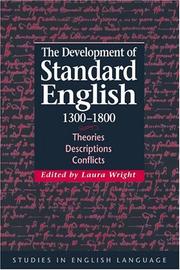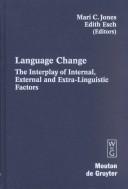| Listing 1 - 10 of 13 | << page >> |
Sort by
|

ISBN: 0521771145 0521029694 0511551754 9780521029698 9780521771146 9780511551758 Year: 2006 Volume: *2 Publisher: Cambridge Cambridge University Press
Abstract | Keywords | Export | Availability | Bookmark
 Loading...
Loading...Choose an application
- Reference Manager
- EndNote
- RefWorks (Direct export to RefWorks)
There are many questions yet to be answered about how Standard English came into existence. The claim that it developed from a Central Midlands dialect propagated by clerks in the Chancery, the medieval writing office of the king, is one explanation that has dominated textbooks to date. This book reopens the debate about the origins of Standard English, challenging earlier accounts and revealing a far more complex and intriguing history. An international team of fourteen specialists offer a wide-ranging analysis, from theoretical discussions of the origin of dialects, to detailed descriptions of the history of individual Standard English features. The volume ranges from Middle English to the present day, and looks at a variety of text types. It concludes that Standard English had no one single ancestor dialect, but is the cumulative result of generations of authoritative writing from many text types.
Historical linguistics --- English language --- anno 1500-1799 --- anno 1400-1499 --- anno 1300-1399 --- Standardization. --- History. --- Grammar, Historical. --- -English language --- -Germanic languages --- Grammar, Historical --- History --- Standardization --- -Grammar, Historical --- Grammar [Historical ] --- Arts and Humanities --- Language & Linguistics --- Germanic languages --- English language - Standardization. --- English language - History. --- English language - Grammar, Historical. --- ANGLAIS (LANGUE) --- NORMALISATION --- 1100-1500 (MOYEN-ANGLAIS) --- 1500-1700 (MODERNE)
Book
ISBN: 9783110687514 9783110687545 3110687542 Year: 2020 Publisher: Berlin De Gruyter Mouton
Abstract | Keywords | Export | Availability | Bookmark
 Loading...
Loading...Choose an application
- Reference Manager
- EndNote
- RefWorks (Direct export to RefWorks)
Textbooks inform readers that the precursor of Standard English was supposedly an East or Central Midlands variety which became adopted in London; that monolingual fifteenth century English manuscripts fall into internally-cohesive Types; and that the fourth Type, dating after 1435 and labelled ‘Chancery Standard’, provided the mechanism by which this supposedly Midlands variety spread out from London. This set of explanations is challenged by taking a multilingual perspective, examining Anglo-Norman French, Medieval Latin and mixed-language contexts as well as monolingual English ones. By analysing local and legal documents, mercantile accounts, personal letters and journals, medical and religious prose, multiply-copied works, and the output of individual scribes, standardisation is shown to have been preceded by supralocalisation rather than imposed top-down as a single entity by governmental authority. Linguistic features examined include syntax, morphology, vocabulary, spelling, letter-graphs, abbreviations and suspensions, social context and discourse norms, pragmatics, registers, text-types, communities of practice social networks, and the multilingual backdrop, which was influenced by shifting socioeconomic trends.
Historical linguistics --- Sociolinguistics --- English language --- Historical Sociolinguistics --- Medieval Multilingualism --- Standardisation of English --- E-books
Book
ISBN: 9781003020875 1003020879 9781000364583 1000364585 9781000364606 1000364607 9780367897468 0367897466 9780367742300 Year: 2021 Publisher: London Routledge, Taylor & Francis Group
Abstract | Keywords | Export | Availability | Bookmark
 Loading...
Loading...Choose an application
- Reference Manager
- EndNote
- RefWorks (Direct export to RefWorks)
Philosophy and psychology of culture --- Social ethics --- Nutritionary hygiene. Diet
Book
ISBN: 9783111348896 Year: 2024 Publisher: Basel De Gruyter, Inc.
Abstract | Keywords | Export | Availability | Bookmark
 Loading...
Loading...Choose an application
- Reference Manager
- EndNote
- RefWorks (Direct export to RefWorks)
This book teaches the basics of the structure of the English language with plentiful extracts from novels, poems and plays, so that literature students learn how to identify parts of speech and discuss their effects. No previous linguistics experience is assumed. Each chapter is divided into a definition of a specific linguistic feature; a demonstration of it in a literary text; a literary exercise where readers identify it themselves and assess its effect; and a brief summary of the teaching point. Interpretation is subjective and readers will learn how to build linguistic evidence to support their view. Essential knowledge for anyone who analyses English Literature.
Book
ISBN: 9781474493314 9781474493338 9781474493321 Year: 2022 Publisher: Edinburgh Edinburgh University Press
Abstract | Keywords | Export | Availability | Bookmark
 Loading...
Loading...Choose an application
- Reference Manager
- EndNote
- RefWorks (Direct export to RefWorks)
English literature --- American literature --- Veganism in literature. --- Ethics in literature. --- Food habits in literature. --- Littérature anglaise. --- Littérature américaine. --- Véganisme --- Morale --- Alimentation --- History and criticism. --- Dans la littérature. --- Littérature anglaise. --- Littérature américaine. --- Véganisme --- Dans la littérature.
Book
ISBN: 9781009057394 1009057391 9781009054911 100906309X 1009063294 Year: 2023 Publisher: Cambridge Cambridge University Press
Abstract | Keywords | Export | Availability | Bookmark
 Loading...
Loading...Choose an application
- Reference Manager
- EndNote
- RefWorks (Direct export to RefWorks)
Shakespeare's visionary women, usually confined to the periphery, claim centre stage to voice their sleeping and waking dreams. These women recount their visions through acts of rhetoric, designed to persuade and, crucially, to directly intervene in political action. The visions discussed in this Element are therefore not simply moments of inspiration but of political intercession. The vision performed or recounted on stage offers a proleptic moment of female speech that forces audiences to confront questions of narrative truth and women's testimony. This Element interrogates the scepticism that Shakespeare's visionary women face and considers the ways in which they perform the truth of their experiences to a hostile onstage audience. It concludes that prophecy gives women a brief moment of access to political conversations in which they are not welcome as they wrest narrative control from male speakers and speak their truth aloud.
Women in literature. --- Visions in literature. --- Shakespeare, William, --- Criticism and interpretation. --- Characters.
Book

ISBN: 1283400243 9786613400246 3110253364 9783110253368 9783110253351 3110253356 9781283400244 6613400246 Year: 2011 Publisher: Berlin Boston
Abstract | Keywords | Export | Availability | Bookmark
 Loading...
Loading...Choose an application
- Reference Manager
- EndNote
- RefWorks (Direct export to RefWorks)
The complex linguistic situation of earlier multilingual Britain has led to numerous contact-induced changes in the history of English. However, bi- and multilingual texts, which are attested in a large variety of text types, are still an underresearched aspect of earlier linguistic contact. Such texts, which switch between Latin, English and French, have increasingly been recognized as instances of written code-switching and as highly relevant evidence for the linguistic strategies which medieval and early modern multilingual speakers used for different purposes. The contributions in this volume approach this phenomenon of mixed-language texts from the point of view of code-switching, an important mechanism of linguistic change. Based on a variety of text types and genres from the medieval and Early Modern English periods, the individual papers present detailed linguistic analyses of a large number of texts, addressing a variety of issues, including methodological questions as well as functional, pragmatic, syntactic and lexical aspects of language mixing. The very specific nature of language mixing in some text types also raises important theoretical questions such as the distinction between borrowing and switching, the existence of discrete linguistic codes in earlier multilingual Britain and, more generally, the possible limits of the code-switching paradigm for the analysis of these mixed texts from the early history of English. Thus the volume is of particular interest not only for historical linguists, medievalists and students of the history of English, but also for sociolinguists, psycholinguists, language theorists and typologists.
Code switching (Linguistics) --- English language --- Middle English language --- Anglo-Saxon language --- Old English language --- West Saxon dialect --- Germanic languages --- Old Saxon language --- Language shift --- Switching (Linguistics) --- Bilingualism --- Linguistics --- Diglossia (Linguistics) --- Variation --- Script switching (Linguistics) --- Englisch/Language. --- Historical Linguistics. --- Language Contact and Change. --- Pragmatics. --- Romance Languages.
Book

ISBN: 9783110577549 3110575310 3110577542 Year: 2018 Publisher: Berlin Boston
Abstract | Keywords | Export | Availability | Bookmark
 Loading...
Loading...Choose an application
- Reference Manager
- EndNote
- RefWorks (Direct export to RefWorks)
English language --- Germanic languages --- Dialects --- Variation
Book

ISBN: 9781501503542 1501503545 1501503413 9781501503412 9781501511608 1501511602 Year: 2017 Publisher: Berlin Boston
Abstract | Keywords | Export | Availability | Bookmark
 Loading...
Loading...Choose an application
- Reference Manager
- EndNote
- RefWorks (Direct export to RefWorks)
Traders around the world use particular spoken argots, to guard commercial secrets or to cement their identity as members of a certain group. The written registers of traders, too, in correspondence and other commercial texts show significant differences from the language used in official, legal or private writing. This volume suggests a clear cross-linguistic tendency that mercantile writing displays a greater degree of language mixing, code-switching and linguistic innovations, and, by setting precedents, promote language change.This interdisciplinary volume aims to place the traders' languages within a wider sociolinguistic context. Questions addressed include: What differences can be observed between mercantile registers and those of court or legal scribes? Do the traders' texts show the early emergence of features that take longer to permeate into the 'higher' varieties of the same language? Do they anticipate language change in the standard register or influence it by setting linguistic precedents? What sets traders' letters apart from private correspondence and other 'low' registers? The book will also examine bilingualism, semi-bilingualism, reasons for code-switching and the choice of particular languages over others in commercial correspondence.
Language and languages --- Multicultural education. --- Multilingualism --- Study and teaching. --- Social aspects. --- Plurilingualism --- Polyglottism --- Intercultural education --- Education --- Culturally relevant pedagogy --- Foreign language study --- Language and education --- Language schools --- Multicultural education --- Study and teaching --- Social aspects --- E-books --- Culturally sustaining pedagogy --- Multilingualism Social aspects --- Language and languages Study and teaching --- Historical Linguistics. --- Language Change and Variation. --- Merchants. --- Registers.


ISBN: 3110892596 9783110892598 311017202X 9783110172027 Year: 2011 Publisher: Berlin Boston
Abstract | Keywords | Export | Availability | Bookmark
 Loading...
Loading...Choose an application
- Reference Manager
- EndNote
- RefWorks (Direct export to RefWorks)
Linguistic change. --- Languages in contact. --- Areal linguistics --- Change, Linguistic --- Language change --- Historical linguistics --- Language and languages --- Linguistic change --- Languages in contact
| Listing 1 - 10 of 13 | << page >> |
Sort by
|

 Search
Search Feedback
Feedback About UniCat
About UniCat  Help
Help News
News